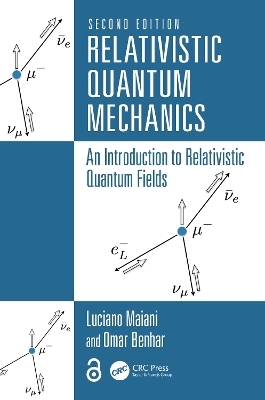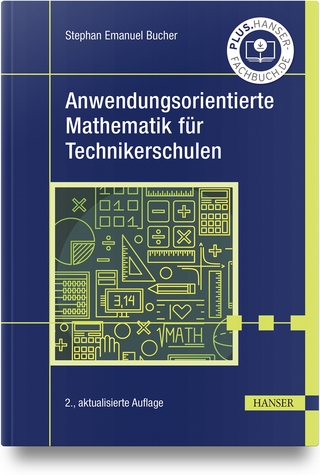
Relativistic Quantum Mechanics
CRC Press (Verlag)
978-1-032-56594-1 (ISBN)
The introductory chapters of the book summarise the theory of special relativity and its application to the classical description of the motion of a free particle and a field. The authors then explain the quantum formulation of field theory through the simple example of a scalar field described by the Klein–Gordon equation as well as its extension to the case of spin ½ particles described by the Dirac equation. They also present the elements necessary for constructing the foundational theories of the standard model of electroweak interactions, namely quantum electrodynamics and the Fermi theory of neutron beta decay. Many applications to quantum electrodynamics and weak interaction processes are thoroughly analysed. The book also explores the timely topic of neutrino oscillations.
Logically progressing from the fundamentals to recent discoveries, this textbook provides students with the essential foundation to study more advanced theoretical physics and elementary particle physics. It will help them understand the theory of electroweak interactions and gauge theories.
View the second and third books in this collection: Electroweak Interactions and An Introduction to Gauge Theories.
Key Features of the new edition:
Besides a general revision of text and formulae, three new chapters have been added.
· Chapter 17 introduces and discusses double beta decay processes with and without neutrino emission, the latter being the only process able to determine the Dirac or Majorana nature of the neutrino (discussed in Chapter 13). A discussion of the limits to the Majorana neutrino mass obtained recently in several underground laboratories is included.
· Chapter 18 illustrates the calculation of the mass spectrum of “quarkonia” (mesons composed by a pair of heavy, charm or beauty quarks), in analogy with the positronium spectrum discussed in Chapter 12. This calculation has put into evidence the existence of “unexpected” states and has led to the new field of “exotic hadrons”, presently under active theoretical and experimental scrutiny.
· Chapter 19 illustrates the Born-Oppenheimer approximation, extensively used in the computation of simple molecules, and its application to the physics of exotic hadrons containing a pair of heavy quarks, with application to the recently observed doubly charmed baryons.
This eBook was published Open Access with funding support from the Sponsoring Consortium for Open Access Publishing in Particle Physics (SCOAP3).
A PDF version of this book is available for free in Open Access at www.taylorfrancis.com. It has been made available under a Creative Commons Attribution-Non Commercial-No Derivatives 4.0 license.
Luciano Maiani, born in 1941, is emeritus professor of theoretical physics at the University of Rome, "La Sapienza", and author of more than two hundred scientific publications on the theoretical physics of elementary particles. He, together with S. Glashow and J. Iliopoulos, made the prediction of a new family of particles, those with "charm", which form an essential part of the unified theory of the weak and electromagnetic forces. He has been president of the Italian Institute for Nuclear Physics (INFN), Director-General of CERN in Geneva and president of the Italian National Council for Research (CNR). He promoted the development of the Virgo Observatory for gravitational wave detection, the neutrino beam from CERN to Gran Sasso and at CERN directed the crucial phases of the construction of the Large Hadron Collider. He has taught and worked in numerous foreign institutes. He was head of the theoretical physics department at the University of Rome, "La Sapienza", from 1976 to 1984 and held the chair of theoretical physics from 1984 to 2011. He is a member of the Italian Lincean Academy and a Fellow of the American Physical Society. Omar Benhar, born in 1953, is an INFN research director and teaches gauge theories at the University of Rome, "La Sapienza". He has worked extensively in the USA as visiting professor, at the University of Illinois and the Old Dominion University, as well as associate scientist at the Thomas Jefferson National Accelerator Facility. Since 2013, he has served as an adjunct professor at the Centre for Neutrino Physics of Virginia Polytechnic Institute and State University. He is the author of more than a hundred scientific papers on the theory of many-particle systems, the structure of compact stars and electroweak interactions of nuclei.
Chapter 1: The Symmetries of Space-Time. Chapter 2: The Classical Free Particle. Chapter 3: The Lagrangian Theory of Fields. Chapter 4: The Klein-Gordon Field Quantisation. Chapter 5: Electromagnetic Field Quantisation. Chapter 6: The Dirac Equation. Chapter 7: Quantisation of the Dirac Field. Chapter 8: Free Field Propagators. Chapter 9: Interactions. Chapter 10: Time Evolution of Quantum Systems. Chapter 11: Relativistic Perturbation Theory. Chapter 12: The Discrete Symmetries: P, C, T. Chapter 13: Weyl and Majorana Neutrinos. Chapter 14: Applications: QED. Chapter 15: Applications: Weak Interactions. Chapter 16: Neutrino Oscillations. Chapter 17: Neutrinoless Double-Beta Decay. Chapter 18: A Leap Forward: Charmonium. Chapter 19: The Born-Oppenheimer Approximation for the Doubly Charmed Baryon. Appendix A: Basic Elements of Quantum Mechanics. Appendix B: The Non-relativistic Hydrogen Atom. Bibliography. Index.
| Erscheinungsdatum | 09.03.2024 |
|---|---|
| Zusatzinfo | 13 Tables, black and white; 30 Line drawings, black and white; 1 Halftones, black and white; 31 Illustrations, black and white |
| Verlagsort | London |
| Sprache | englisch |
| Maße | 156 x 234 mm |
| Gewicht | 866 g |
| Themenwelt | Mathematik / Informatik ► Mathematik ► Angewandte Mathematik |
| Naturwissenschaften ► Biologie | |
| Naturwissenschaften ► Physik / Astronomie ► Atom- / Kern- / Molekularphysik | |
| Naturwissenschaften ► Physik / Astronomie ► Festkörperphysik | |
| Naturwissenschaften ► Physik / Astronomie ► Hochenergiephysik / Teilchenphysik | |
| Naturwissenschaften ► Physik / Astronomie ► Quantenphysik | |
| ISBN-10 | 1-032-56594-2 / 1032565942 |
| ISBN-13 | 978-1-032-56594-1 / 9781032565941 |
| Zustand | Neuware |
| Haben Sie eine Frage zum Produkt? |
aus dem Bereich


